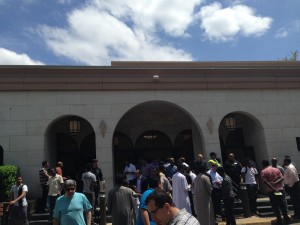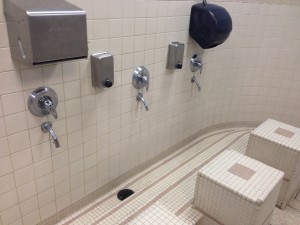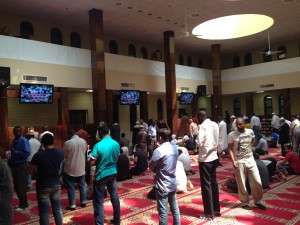
I attended my second Jummah yesterday at the Dar al Hijrah Mosque yesterday afternoon. It’s only a 10 minute drive from both my work and home, so I left the office around 1 PM thinking I would have plenty of time to find it and get parking.
I got to the mosque and the first thing I noticed was that there were a ton of Muslims walking around the area. Most of the women wore Hijabs, which was a bit strange to see in a suburban American neighborhood.
What I found most hilarious though, was the traffic situation.
The mosque is located in a nice Virginia neighborhood right off a major road. There was very little dedicated parking for the mosque. For this reason, most people had to find street parking in the neighborhood.
The problem was the parking was permit parking only. I didn’t have a permit, nor did most of the Muslims trying to go to the mosque.
Everyone was looking for the mythical street with non-permit parking. I saw lots of attempted u-turns on crowded streets, stand-offs between cars moving in the opposite direction, and lots of pedestrians just weaving their way through the traffic.
I felt like I was back in Egypt!
The other funny thing was that there were a lot of cabs in the neighborhood, as being a cab driver is a popular job with Muslim immigrants. The stereotype was definitely true in this case.
I decided to take my chances and park on a permit-only street. It was a little farther away from the mosque than I would have liked, but still close enough to walk. I figured that Allah would forgive my transgression, as I was trying to make it to prayers on time. I wasn’t so sure if the cop walking around with the ticket pad would.
My Egyptian, walk-through-crazy-traffic skills paid off as I made it to the mosque with a few minutes to spare.
The first thing I did was head to bathroom/washroom to perform Wudu, or ablution. I took my shoes and socks off and put on some house sandals.

In the bathroom there were a bunch of washing stations that consisted of individual stools, faucets, and a communal basin or drain. It was set up so that you could easily go through the process of washing your hands, arms, face, nose, mouth, and feet.
I sat down on one of the benches and began doing my thing. I looked around to make sure the way I learned to do Wudu wasn’t radically different from everyone else.
It wasn’t (though I may have gotten the order wrong).
I washed my hands first, then my forearms, then my face, then I snorted water, then I rinsed my mouth, then my hair and ears, and then finally my feet.
I dried off with some paper towels, and then headed to the prayer room.

There were actually two adjacent prayer rooms with a glass wall separating the two. I suspect the purpose was to use one of the spaces for women, but both spaces were occupied by men.
There were a few TV screens installed so that you could see the Imam from the rear room (which I was in).
I noticed a few people did their own prayers before the Imam started so I went through a few Rakat on my own, you know, just to fit in.
The Imam gave his sermon, which lasted about 20 minutes. It was about maintaining your faith in God during hardship and the obligation all Muslims have to correcting injustices in the world.
It was a bit hard to follow because the Imam had a fairly strong accent, and the sermon was partially in Arabic. He would recite bits of the Quran and then give an explanation in English.
When the sermon was finished, we began the prayer.
In a communal prayer, it is customary for everyone to line up in rows and not leave any gaps in the line. It has to do with not leaving any room for Shaytan (Satan) to enter. You are supposed to stand “shoulder to shoulder” and “feet to feet.”
I got cozy with some of my fellow congregants.
The lack of personal space thing is a l bit uncomfortable, but I’ve been in worse situations. In the military, when we had to line up in a somewhat confined space, we were told to stand “nut to butt.” That was much more awkward than shoulder to shoulder.
I was able to not make a fool of myself during the prayer. There were some minor variations in the ways people performed there prayer though. For example, when transitioning between standing and bowing, some people would raise their hands to their ears and then bow, while others (like myself) would just move straight to the bowing.
The prayer only took a few minutes. It was pretty cool to be in sync with other Muslims in an important spiritual ritual. I suspect that’s one of the reasons why it is encouraged, to foster that sense of connection between Muslims.
I left the mosque shortly after the prayer ended. Many people stuck around to chat and eat (they were selling food) and have a good time, which wasn’t so different from what happens after a Mass or Shabbat service.
I walked back to my car and found that God protected my car from the evil parking ticket cop.
Hamdullah (Praise be to God)